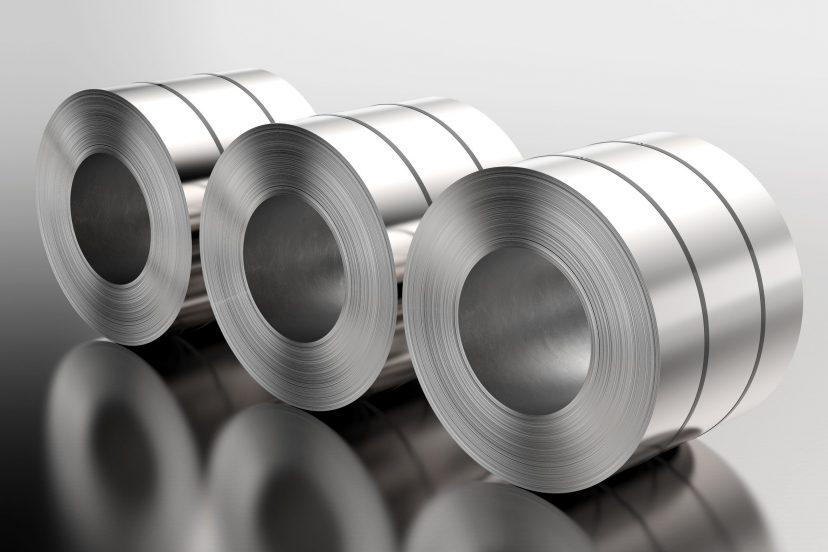On April 3, 1973, the first mobile phone was created. Since then, cell phone technology has…
Does Steel Block Radiation?

*We may earn a commission for purchases made using our links. Please see our disclosure to learn more.
Steel has a number of different purposes. It’s used in construction, in crafting, in jewelry, and even in spacecraft. With so many different applications, a natural next question would be: does steel block radiation?
The answer is that it actually does, at least under the right circumstances. In this guide, we will dive a little deeper into steel. We’ll look at what it is, and what makes it radioprotective. We’ll also take a look at some products that make use of steel.
Let’s get started.
What is steel?
Steel is a metal, but it is not one that you can find on the periodic table of elements. To find out where steel comes from, we first need to look to another metal: iron. Iron is the 26th element, and it is actually the most common element there is. Abundant amounts of it can be found across the globe, as iron naturally occurs inside both the Earth’s outer crust and inner core.
True iron is quite difficult to access, at least in its metallic state. Most of the iron used in manufacturing actually comes from ores, which are simply rocks that the metal can be extracted from. Iron ore varies in color, but it’s usually a deep red or dark grey color. Iron is extracted from the ore by a process called smelting, which involves heating up the rock to a certain temperature and occasionally using chemicals to eat away at the ore itself, leaving behind the metal.
Interesting, sure. But how does any of that relate to steel?
Steel, it turns out, is an iron alloy. That is, it is derived from iron, with other elements added in. Think of a designer dog breed. Over time, breeders have cherry-picked traits from different dog breeds in order to create dogs that are hypoallergenic and family-friendly. Steel is kind of like that. Iron is the base mineral used, but additional carbon is added to increase the overall strength and durability.
Other metals can be added, as well. For example, in the case of stainless steel, chromium is added in because of its resistance to rust and corrosion.
The process to create steel begins during smelting, as the iron is extracted. During the initial extraction, the iron possesses an excessive amount of carbon. In order to make steel, much of this carbon must be removed, while other metals are added in. The bulk of the steel made today is done using continuous casting, where the extracted iron is shaped into a slab. The slab is exposed to heat in order to add in the extra elements and it then undergoes additional processing.
Steel has been around for quite some time. The oldest known steel dates back to 1800 BC. In modern times, it serves a variety of purposes and is used in everything from agriculture to high-rise buildings.
Does steel block radiation?
Long story short, there’s not an easy answer to this question. Really, it depends. There are different types of radiation and different types of stainless steel, and some types of steel are effective against some types of radiation.
You may remember from other articles on this website that radiation can be broken down into two categories: ionizing and non-ionizing. Ionizing radiation encompasses x-rays, UV rays, gamma rays, and other high-energy waves on the electromagnetic spectrum. Non-ionizing radiation, on the other hand, includes radio frequency (RF) waves, extremely-low frequency (ELF) waves, infrared waves, and microwaves. Non-ionizing radiation has much less energy, overall.
Those are the basics. If you’re curious to learn more, we dive further into detail in a few other places on this website. The Difference Between Ionizing and Non-Ionizing Radiation and EMF Radiation: Everything You Need To Know are both good sources of information to get you started.
With ionizing radiation, blocking it is all about density. Any dense metal can keep ionizing waves from penetrating through, although the precise density requires varies based on the type of ionizing radiation. Alpha particles, for example, can be stopped by a single sheet of paper, whereas x-rays require a much thicker material such as lead. In that instance, steel may or may not be effective at blocking radiation, depending on the thickness of that particular sheet and the type of radiation in question.
Ionizing radiation is something we are exposed to in small quantities every day, via cosmic background radiation, airplane flights, medical testing, and more. Protection is generally more about avoidance and minimizing exposure than using a shielding material, and unless you are preparing for an atomic bomb or some other nuclear fallout, you wouldn’t necessary need to safeguard your house from ionizing radiation.
Non-ionizing radiation, meanwhile, is much more common in everyday life. Reducing your exposure is partially about avoiding it as much as possible, to be sure. But if you live in a city or use modern technology, shielding materials can help protect you from sources of non-ionizing radiation, as well.
Non-ionizing radiation requires conductivity in blocking materials. Its much longer waves can penetrate thicker objects, so to block it, you need to somehow interrupt the signal. This can be done using conductive material. Most often, copper or nickel is used in EMF protection products, because it is both conductive and inexpensive.
Steel’s ability to block non-ionizing EMF radiation, then, lies in its conductivity. You may remember from when we talked about how steel is made earlier that it is an iron alloy, often with other metals added in. For that reason, some types of steel are magnetic and some are not. For example, 400-series stainless steel is magnetic whereas 300-series stainless steel is not.
Products with steel
While steel may not be the most popular material of choice with manufacturers when it comes to EMF blocking products, it has been used in a few good ones. Below are some examples. It’s also worth noting that stainless steel can be used as a raw material to create a protective item of your own, such as a smart meter cover or router guard.
Smart Meter Guard Smart Meter Cover
Smart meters are well known as a significant source of radiation in homes that use them. And if your community allows you the option to opt-out of smart meter usage, there is often an added fee associated with having an employee manually read your meter. Smart meters are problematic for a number of reasons, which we go over in greater detail in Smart Meter Radiation: What You Should Know.
One part of combatting this radiation is using a smart meter cover, which is a sort of Faraday cage that helps absorb some of the RF radiation being put out by the device. Smart Meter Guard’s Smart Meter Cover is one such device, made from stainless steel. This cover blocks up to 98% of EMF radiation put out by a smart meter, while still allowing utility data to penetrate through.
EMF Essentials WiFi Router Cover
WiFi is a major source of EMF radiation in many homes. The signal usually reaches the far corners of the house, including our bedrooms and other areas where we spend a great deal of time. This is great from a connectivity standpoint, but less than ideal when it comes to reducing your EMF exposure. And while the best option is to switch to a hardwired connection, that is not an option for everyone. If you must use WiFi, you can cut down on your exposure through the use of a WiFi router guard.
EMF Essentials WiFi Router Cover cuts EMF radiation by about 90%, with no noticeable reduction in signal quality. It is made from stainless steel and includes slots that you can pass an ethernet cord and power cable through. All you do is put your router inside, hook it up to the cables, and close the lid on the box.
Testing your items
If you decide to purchase an EMF protective product made from stainless steel, or if you use stainless steel to create your own, you may want to test your item’s effectiveness. You can do this using an EMF meter. We generally recommend TriField’s TF2 because it is both accurate and reliable, as well as capable of detecting RF radiation in addition to electric and magnetic fields. For other options, see The Best EMF Meters For Any Budget.
To test your protective item, you will need to take two measurements: one with the device on and one with it off. That may look different depending on the specific product at hand, but let’s take a look at one example.
If you purchased a smart meter guard and wanted to test it, you would first use your EMF meter to take a reading next to the meter without the guard installed. You could move the meter to various distances, as well, and observe how the reading changes at different locations. Next, install the smart meter guard and then repeat your measurements.
If the product is effective, you should notice a significant reduction in the EMF level with it installed versus without.
Final thoughts
Steel is just one material capable of blocking radiation. For others, see What Materials Block Radiation. 



